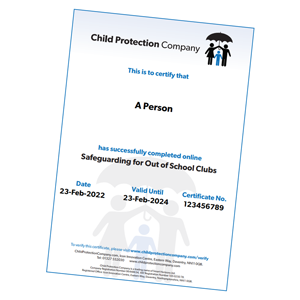Safeguarding for Out of School Clubs
Conference Offer - Get 50% discount off using the code CONF50 at the checkout (expires 31 March 2025)
Only £15.00 + VAT per course
RRP: £30.00 + VAT per course
This course is most suitable for those working in private, independently-run out of school Clubs. Our '3-in-1' course covers conventional child protection practices, alongside online safety and the Prevent duty. A valuable tool for staff, leaders and managers which fulfils Ofsted requirements.
Use Discount Code: CONF50 at the checkout.


The course was structured very well with useful links and resources and had me engaged. The scenarios were very poignant and relevant to our working environment. I really felt this was one of the best CPD's I have experienced in a long time. I was very impressed.
Shahjahan Goni, Denbigh High School
5 stars all the way!
Jeremy Clifton, Woodbridge High School
Key Features
Management System
Our online learning management system has been built to solve the problem of maintaining central records for all safeguarding and child protection training and ensuring that everyone’s training is current and up-to-date. If an inspecting body wants to check your records, simply use our website to display a full record of staff training certificates.
You can also set up automatic reminder emails to ask your users to take or retake training. You can tailor these emails and the timings for sending and you can even specify that the email appears to come from yourself. Once enabled, the training system will manage all of the chasing for you.
FAQ
This online training course covers the safeguarding requirements for England, Scotland, Wales and Northern Ireland. When you begin the course, you will be offered a choice of location. Your learning channel is designed to meet the needs of Ofsted, Education Scotland, Education Training Inspectorate and Estyn, depending on the country you select.
The content of the safeguarding course draws on appropriate guidance from sources, such as:
- Working Together to Safeguard Children
- National Guidance for Child Protection in Scotland
- Getting it Right for Every Child
- Safeguarding Children – Working Together Under the Children’s Act 2004 (Wales)
- Co-operating to Safeguard Children and young people in Northern Ireland
This safeguarding course offers an introduction to child protection specifically for staff working privately-run out of school clubs. If your out of school club is managed by the school, you should look at our Safeguarding in Education course.
We regularly update the Safeguarding for Out of School Clubs course to ensure that it is in line with any new legislation or policy changes. There will inevitably be changes when you come to retake your safeguarding training.
“The course was structured very well with useful links and resources and had me engaged. The scenarios were very poignant and relevant to our working environment. I really felt this was one of the best CPD’s I have experienced in a long time. I was very impressed with the course.”
Shahjahan Goni, Denbigh High School
Details / Benefits
- Instant access to courses
- Training can be taken any time – no need for staff to even be on site
- Takes between 1-2 hours to complete
- Courses can be taken 24/7 online or on mobile devices
- Cheaper than face-to-face training
- No need to take time out of work to undertake training
- No requirements for minimum or maximum group sizes
- Retrieve centrally held online certificates at the touch of a button
- Downloadable Excel reports so you can monitor completion
- Individual, personalised certificates can be downloaded and printed
- Automated reminders when training is due for renewal
- Courses can be stopped and restarted at any point
- Course notes and resources available for the duration of certification
- Friendly, UK-based customer support centre in case you have any queries
- Regularly updated to meet legislation changes
- Regional variants available for England, Scotland, Wales and Northern Ireland
- Provides information, scenarios and downloads specific to the education sector
Certification
Upon successful completion of the course, you’ll be able to download a personalised safeguarding training certificate valid for 2 years.

Course Content
This course provides an introduction to safeguarding for those working in privately-run out of school clubs. It focuses on a range of safeguarding issues, including abuse, radicalisation, online safety and associated areas. The content will offer guidance on how to take action in relation to safeguarding and it is suitable for anyone working in a privately-run out of school care environment.
There are also versions for those based in Scotland, Wales and Northern Ireland, to account for some regional variations in the course content. You can choose the most appropriate route at the start of the course.
Once you have completed the course, you will:
- Have an awareness of the legislation and guidance surrounding safeguarding and the protection of children
- Be able to define the different types of child abuse
- Be able to demonstrate an awareness of the various indicators of abuse and neglect
- Be able to recognise vulnerabilities to radicalisation
- Understand potential online safety risks
- Be aware of the effects of personal values and attitudes towards abuse
- Understand your responsibility to report concerns
- Be aware of the importance of maintaining a child focus
- Be able to demonstrate an awareness of the actions to take in the event of suspected abuse
This short, scenario-based module is designed to help you assess your current knowledge and begin thinking about issues surrounding abuse and safeguarding that may manifest.
By the end of the module, you will have a clearer understanding of your own level of knowledge.
It is a sad truth that child abuse, radicalisation, cyberbullying and child sexual exploitation are all still common in the United Kingdom. This module will introduce you to the terminology of safeguarding and will define key words and concepts that will inform the rest of the course.
By the end of the module, you will have an increased awareness of those most vulnerable to abuse, on what scale abuse occurs and the definitions of key terms such as ‘child’ and ‘safeguarding’.
Over the years, a number of pieces of legislation and guidance have been implemented to help safeguard and protect young people and children in the United Kingdom. The purpose of this module is to help you understand what legislation is in place and why it is needed. You will not be expected to be able to quote the laws themselves, but it will help with good safeguarding practice if you have an overview of them. It is vital that all staff understand the role of the Designated Safeguarding Lead Person (DSL), so this module also looks at their responsibilities.
Depending on the regional variant you select, England, Wales, Scotland or NI the course takes into account:
- Working Together 2018
- The Rights of Children and Young Persons Measure (Wales)
- Getting It Right for Every Child (Scotland)
- Co-operating to Safeguard Children and young people in Northern Ireland
By the end of the module, you will have a better understanding of the main safeguarding-related legislation and guidance. You will also consider the vital role played by the DSL in ensuring that effective safeguarding takes place.
This module will support your ability to recognise those children and young people who are potentially at risk. You will look at what safeguarding is concerned with and this will help you to define the main kinds of child abuse. It will then move on to consider the specific categories of abuse.
This module will explore specific types of abuse and safeguarding concerns. Examples include peer-on-peer abuse, child criminal exploitation and harmful sexual behaviour.
It offers you both an understanding of these specific concerns and a capacity to identify children/young adults potentially at risk.
The increased use of technology by young people and children brings many benefits and, sadly, a few dangers. This module looks at the role of safeguarding when it comes to online safety. The content will give you an overview of the potential for risk when children are online, in relation to, amongst other areas, grooming, sexting and cyberbullying. The module will remind you of the legal position should you become aware of an incident, and will outline ways of empowering children to be safe and report issues when online.
By the end of the module, you will have extended your knowledge of the risks associated with technology, the different aspects of online safeguarding in education, specific risks children may be exposed to, and effective online safety practice.
All schools have a legal duty to prevent pupils from being drawn into extremism. Staff are expected to challenge extremist ideas and recognise when children are at risk, and Ofsted will expect to see school leaders and governors taking steps to protect children from radicalisation and extremist views.
This module places the Prevent strategy in context and considers the ways in which radicalisation can affect a young person, and the groups that may attempt to induct a young person into their ideology.
By the end of the module, you will have a greater understanding of the signs of radicalisation in young people and what to do should you feel a child or young person is in danger under the Prevent strategy.
The focus when working on safeguarding or dealing with potential abuse must be the safety of the child or young person. Maintaining a child focus is key to the process of identification and reporting, because unfortunately, children sometimes report several times before any action is taken. The learning you will complete in this module will be contextualised in a realistic situation, so that you can see how a child focus can be achieved.
By the end of this module, you will have a better understanding of what it means to be child-centred in your approach, and the responsibilities of carers in relation to documenting decisions.
This part of the course builds on the work we did in earlier modules. Children can disclose in a number of ways, so while you want to maintain confidentiality where appropriate, you also need to know when to report and to whom. It is vital that you respond quickly and appropriately when presented with a disclosure of abuse, and this module covers the right process to follow and what to do (and what not to do) to achieve the desired outcome.
By the end of this module, you will have a better understanding of the correct procedures to follow in response to a potential abuse situation and will know what to do if you have concerns about the behaviour of an adult. A step-by-step guide is included, which will help you to refer any concerns you may have.
You will now take all you have learned and apply it to an assessment of your knowledge. The final assessment is your opportunity to show how much you have absorbed and why it is so important to have child protection training.
Once you have passed your assessment, you will be able to download your certificate. Your pass rate will be 70% but don’t worry if you do not pass the first time, as you can take the test multiple times.
Course Costs
Number of Courses
- 1
- 10
- 20
- 50
- 75
- 100
Total Cost (ex VAT)
- £30.00
- £270.00
- £510.00
- £1,200.00
- £1,687.50
- £2,100.00
Total Cost (inc VAT)
- £36.00
- £324.00
- £612.00
- £1,440.00
- £2,025.00
- £2,520.00
Cost Per Course (ex VAT)
- £30.00
- £27.00
- £25.50
- £24.00
- £22.50
- £21.00
Number of Courses:
1
Total Cost (ex VAT): £30.00
Total Cost (inc VAT): £36.00
Cost Per Course (ex VAT): £30.00
Number of Courses:
10
Total Cost (ex VAT): £270.00
Total Cost (inc VAT): £324.00
Cost Per Course (ex VAT): £27.00
Number of Courses:
20
Total Cost (ex VAT): £510.00
Total Cost (inc VAT): £612.00
Cost Per Course (ex VAT): £25.50
Number of Courses:
50
Total Cost (ex VAT): £1,200.00
Total Cost (inc VAT): £1,440.00
Cost Per Course (ex VAT): £24.00
Number of Courses:
75
Total Cost (ex VAT): £1,687.50
Total Cost (inc VAT): £2,025.00
Cost Per Course (ex VAT): £22.50
Number of Courses:
100
Total Cost (ex VAT): £2,100.00
Total Cost (inc VAT): £2,520.00
Cost Per Course (ex VAT): £21.00
Call us today at 01327 552030!
Or, alternatively:
